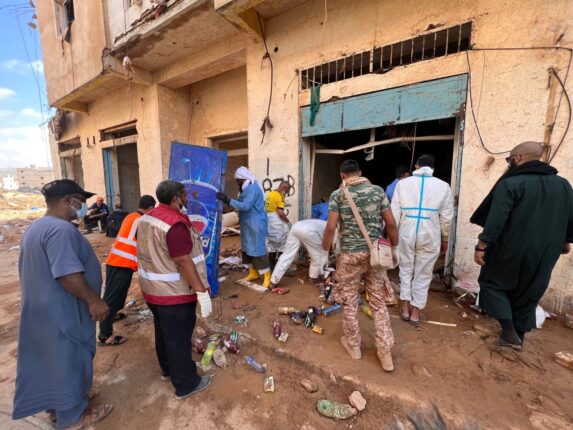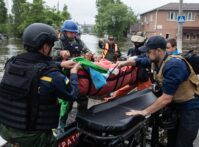-
Water Weaponization in Libya: A Conversation with Erika Weinthal
March 22, 2024 By Wilson Center Staff
Libya provides a case study for the long-term impacts of water weaponization. After the 2011 overthrow of Libyan leader Muammar al-Gaddafi, the country faced civil conflict related to his succession, including two bloody civil wars in 2011, and then from 2014 to 2020, until a ceasefire took effect in 2020. During this period of long-term instability and isolation, Libya’s water infrastructure deteriorated. Combined with the country’s limited water resources, increased demand, and poor management, water insecurity soared.
Erika Weinthal is a specialist in environmental security who focuses on water and energy dynamics as a professor of environmental policy and public policy at Duke University. She has conducted extensive research in water dynamics during conflict, including a recent article written with University of New Hampshire professor Jeannie Sowers in Environment and Security on the targeting of energy and water in Libya’s protracted conflict and the challenges of infrastructure decay. We spoke with Erika about the global challenge of water’s weaponization in war to better understand what this looks like in the context of Libya. The following is a condensed transcript from that interview.
You have noted that Libya’s two brutal civil wars represented a different sort of water weaponization because warring parties sought to control rather than destroy state institutions. How did water weaponization work in Libya’s conflict? What toll did protracted conflict exact on water infrastructure?
EW: Our article builds upon prior work that sought to understand broadly what happens to civilian infrastructure in war—and the way that different forms of infrastructure are targeted. Water, health, agricultural, and energy infrastructure are not targeted similarly across all conflicts, as we see in Yemen, Gaza and the West Bank, and Libya.
In many ways, Libya helps us to grasp the multiple ways that infrastructure is targeted. People often focus on direct airstrikes, shelling, rocket attacks, or drone attacks. In extreme cases, armed forces or militias have carried out what can be considered scorched earth policies—as we’ve seen in places like Chechnya, Syria, and Gaza. If energy plants are destroyed, this generates reverberating effects such that it is impossible to treat and provide drinking water, as in Gaza. In Syria, that was also the case. We don’t see that as much in Libya, just because of the way the infrastructure is constructed. Rather, when it comes to the energy infrastructure in Libya—particulary the oil and gas infrastructure—whoever controls the revenue that comes from this sector controls the vestiges of the Libya’s rentier state. As such, we find different groups vying to control the oil terminals and ports.
In Libya, we’re also seeing other forms of water weaponization in which different parties to the conflict try to capture and control the country’s highly integrated water infrastructure. With water, it’s not about controlling water as a means to control populations, as was often the case in Iraq or Syria with infrastructure such as dams. In Libya, it’s more small-scale looting and sabotage of water infrasructure, threats to the personnel, and obstructing access to repair infrastructure. What that has meant is that the water infrastructure has been used as a way to extract demands or concessions from different warring groups or militias.
Construction on the Great Man-Made River Project began in 1984. It was meant to transfer water from Southern to Northern Libya through a series of pipes. This water source was attacked by warring parties in 2019, which cut off water supplies to the country’s capital, Tripoli. What long-term impacts emerged as a result of the conflict’s impact on the Great Man-Made River Project and the overall destruction of water infrastructure during Libya’s civil wars
EW: The Great Man-Made River project is particularly interesting because it is the core piece of water infrastructure in Libya that was built under Qaddafi and physically unites the country. The Great Man-Made River was an engineering triumph designed to transfer groundwater in the south to the urban centers along the Mediterrean coast.
What we heard in our interviews was a recognition that water still unites the country, and that there was an understanding that you had to keep the infrastructure functioning to provide water to the population throughout the country. Thus, no one group has tried to fully capture and control the entire Great Man-Made River. But when you talk about protracted conflict, even a recognition that everybody needs water and that you have to keep the Great Man-Made river functioning, does not mean that it was made or built to withstand war.
Large feats of engineering are very vulnerable to conflict to war. You might have power outages that disrupt pumps from working, and you may not have the ability to get spare parts, so you have deterioration in the infrastructure. You don’t have the foreign experts who can come in and help sustain and maintain some of this infrastructure. So the Great Man-Made River is highly vulnerable to protracted conflict, because of the disrepair that takes place over long periods of time, and also potential sabotage.
Impacts from protracted conflict also can be seen in desalination plants along the coast. They’ve all fallen into disrepair, so that source of additional drinking water no longer exists. It’s less about these plants being blown up; they just have ceased to function because you can’t manage to maintain them well during a war. You also see the sewage systems damaged in the conflict, resulting in untreated sewage flooding parts of Benghazi at times.
There are certain types of infrastructure that could be more resilient to conflict. Increasingly, people talk about how to design decentralized forms of infrastructure, so if one part goes out, other parts of the system can keep working. The Great Man-Made River project is, however, completely centralized and highly sophisticated. Maintenance has become quite difficult during the conflict. There are multiple points of vulnerability within the Great Man-Made River, ranging from control centers to pumping stations.
Some international humanitarian actors, like the International Committee of the Red Cross, are able to help sustain operations. Not on a day-to-day level, but as we describe in the article, they were able to provide safe access for a truck to deliver spare parts in 2019 for the Great Man-Made River.
Libya was hit hard late last year by severe flooding that destroyed homes, infrastructure, and architecture that had already been weakened by years of conflict. In the aftermath of a period of conflict and stability, and in an environment of existing political tensions, how can states best reconstruct climate-resilient infrastructure?
EW: We’re speaking six months after the floods in Derna. Those floods were highly unusual and exceptional in the damage that transpired. They do expose the increasing vulnerability of conflict-affected and fragile countries to climate change.
Years or decades of conflict largely prevent investments in infrastructure needed to withstand any type of abnormal rainfall, flooding, and many of the dams that would have been able to contain the water. There hadn’t been any investments in the water infrastructure in Libya for years. What these fatal floods underscore, however, is the need to think about rebuilding in conflict affected countries in ways that are climate sensitive.
Right now, everything that I’ve been able to see regarding Libya and the floods is no one wants to take responsibility. There’s very little accountability when institutions and governance are weak. Who should have been working on the maintenance and upkeep? I think that’s part of the first step. There not only has to be an analysis of what failed before you can start rebuilding, but also what is the vision for the future. Until there is some unified government, or some clear path forward of what a post-conflict phase is going to look like, it’s going to be really hard to start rebuilding in Libya in a way that will be climate sensitive.
Both state and nonstate actors were involved in water’s weaponization in Libya. How can the international community respond to the combined impact of state and nonstate actors’ misuse of water resources?
EW: The international community has been paying less attention to Libya—except for the fact that it still has a lot of oil and gas. It’s a messy conflict. The country is largely bifurcated between two competing governments. You have had a large number of foreign governments involved ranging from NATO early on, and then Turkey, supporting the Government of National Accord. The United Arab Emirates, Egypt, and, increasingly, Russia’s Wagner forces have all played a role in the conflict in Libya.
Everybody’s going to want to benefit from any type of peace agreement moving forward. There are ongoing discussions about creating a unified government to bring the parties together. Any government that comes about will still depend on oil and gas revenue. And I think that will be the biggest challenge for Libya. That is their main source of revenue, and that’s what’s going to help fund infrastructure and rebuilding, including in the water sector. Yet, dependence on oil and gas revenue may undercut Libya’s ability to address its vulnerability to climate change.
Libya captures the multiplicity of ways that infrastructure is targeted. Different actors have different interests in conflict, yet civilians are the ones who suffer the most from these attacks on infrastructure. The decay and disrepair of water and sanitation infrastructure must be addressed so as to prevent any spread of waterborne illnesses. And reconstruction must be done in a way that incorporates a changing climate.
Sources: UNICEF, Sage Journals, International Affairs Journal, International Review of the Red Cross, The Tahrir Institute for Middle East Policy, Reuters
Header Photo Credit: Darnah, Libya – September 16, 2023: Rescue operations continue and the body is recovered in the city of Derna, Courtesy of Hussein Eddeb on Shutterstock.com
 A Publication of the Stimson Center.
A Publication of the Stimson Center.







